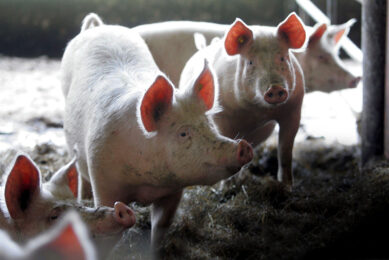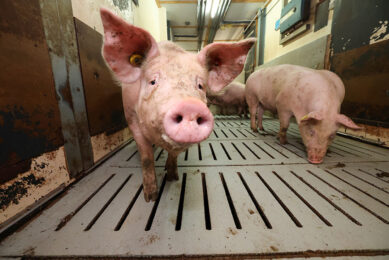Could ice blocks encourage feedback intake for sows?

Providing ice blocks to gestating sows might prove to be worth the while to encourage feedback for sows in group housing, US researchers have found.
Particularly in the US, the practice of feedback is common. Protection against pig gut diseases can be achieved by inducing herd immunity, by providing infected biological material to the sows via controlled exposure. As a result, for instance, rotavirus and Clostridium perfringens are commonly controlled.
Feedback and sow group housing
Reportedly, some US producers have found that the feedback practice has proved to become more difficult when keeping gestating sows in groups, a trend that is applied increasingly more all over the globe, as sows are free to move around. When also using Electronic Sow Feeding (ESF) stations “the shortcomings of feedback in loose-housed sows is even more problematic,” researchers at the University of Pennsylvania wrote, as the sows are not simultaneously fed.

Find all there is to know about pig health using Pig Progress’ unique Pig Health Tool
In a research item that was published in the Journal of Swine Health and Production, they therefore set out to see if providing additional ice blocks to sows might overcome that problem.
Ice blocks as environmental enrichment in pigs
The researchers wrote: “Ice blocks have been investigated previously as sources of environmental enrichment in pigs, and motivated us to consider ice as a possible vehicle for controlled exposure in pen gestation.”
They continued to write, “Other research suggests that most currently known enteric pathogens of swine can be frozen and still be viable. Ice, therefore, could provide a convenient and effective vehicle for controlled exposure of pathogens to pen-gestating sows if sufficient numbers of sows interact with the ice blocks before they melt.”
Dynamic pre-implantation sow gestation pen
The researchers tried the approach in their own swine research and teaching facility at the University of Pennsylvania School of Veterinary Medicine. The 130 sows were housed in a dynamic pre-implantation pen; in a period of 6 weeks, once a week, either 2 or 4 ice blocks were placed in the pens, directly on the slats, at different places. Each block was filmed for 1 hour with a hand-held camera.
The researchers wrote that on average, the “time that individual sows contacted the ice was 93 seconds on days when there were 2 blocks, and 147 seconds when there were 4 blocks.”
The researchers concluded, “This case report shows that when ice was placed in the pen on two consecutive time points 1 week apart, over 90% of the sows in this large dynamic pen contacted the ice. Using 4 blocks instead of 2 blocks increased the number of sows to touch the ice, as well as increasing the duration of contact by individual sows and decreasing aggression at the ice block.”
Social hierarchy among sows
The scientists found that hierarchy among sows did make a difference, but stated: “Social hierarchy influenced aggression at the ice block, as animals with higher social status (animals that ate earlier during the feeding cycle) were more likely to initiate aggression.”
“However, social hierarchy did not impact contact with the ice block, as there was no correlation between feed rank and access to the block. Thus, in this dynamic pen, and given the protocol that was used here, there appeared to be enough time and material for even animals of lower social status to gain access to the ice block.”
Next step to do a test with pathogens
The researchers wrote that a next step could be to follow up the study using pathogens that are of interest to producers and veterinarians.
The research was carried out by Meghann K. Pierdon, Alexandra M. John and Thomas D. Parsons, University of Pennsylvania, Philadelphia, PA, United States.
Join 18,000+ subscribers
Subscribe to our newsletter to stay updated about all the need-to-know content in the pigsector, three times a week. Beheer
Beheer










 WP Admin
WP Admin  Bewerk bericht
Bewerk bericht